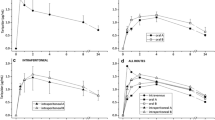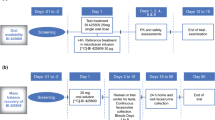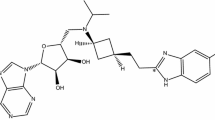Abstract
Bitopertin, a selective glycine transporter 1 (GlyT1) inhibitor, has been extensively studied for the treatment of schizophrenia, with known safety and tolerability profiles in the clinic. Whereas several rodent experiments have been reported, the pharmacokinetic (PK) profile of bitopertin in rodents has not been extensively reported, as only two studies disclosed limited PK parameters in male rats after oral administration. Here, we determined the PK profile of bitopertin in female Sprague-Dawley rats. Blood samples were taken serially, before and after sub-cutaneous (0.03, 0.1, 0.3, 1, and 3 mg/kg) or intra-venous (0.1 mg/kg) administration. Plasma levels were determined by high-performance liquid chromatography coupled with heat-assisted electrospray ionisation tandem mass spectrometry (HPLC-HESI MS/MS). Subsequently, PK parameters were calculated using non-compartmental analysis, including area under the curve (AUC), time (Tmax) to maximal plasma concentration (Cmax), clearance (CL), volume of distribution (Vz), as well as half-life (T1/2). Following sub-cutaneous injection, bitopertin exhibited dose-dependent AUC0-∞ (439.6–34,018.9 ng/mL) and Tmax (3.7–24.0 h), a very long terminal T1/2 (35.06–110.32 h) and low CL (0.07–0.13 L/h/kg), suggesting that bitopertin is slowly absorbed and eliminated in the rat. The observed relationship between dose and the extent of drug exposure (AUC) was linear. Following administration of all sub-cutaneous doses, measured bitopertin plasma levels were comparable to levels achieved with doses already administered in the clinic. We hope that our results will be useful in the design of pre-clinical experiments in which this drug will eventually be administered sub-cutaneously.



Similar content being viewed by others
Data availability
Data are available upon written request to the corresponding author.
References
Alberati D, Moreau J-L, Lengyel J, Hauser N, Mory R, Borroni E, Pinard E, Knoflach F, Schlotterbeck G, Hainzl D (2012) Glycine reuptake inhibitor RG1678: a pharmacologic characterization of an investigational agent for the treatment of schizophrenia. Neuropharmacology 62(2):1152–1161
Armbruster A, Neumann E, Kötter V, Hermanns H, Werdehausen R, Eulenburg V (2018) The GlyT1 inhibitor bitopertin ameliorates allodynia and hyperalgesia in animal models of neuropathic and inflammatory pain. Front Mol Neurosci 10:438
Boetsch C, Parrott N, Fowler S, Poirier A, Hainzl D, Banken L, Martin-Facklam M, Hofmann C (2016) Effects of cytochrome P450 3A4 inhibitors—ketoconazole and erythromycin—on bitopertin pharmacokinetics and comparison with physiologically based modelling predictions. Clin Pharmacokinet 55(2):237–247
Bugarski-Kirola D, Blaettler T, Arango C, Fleischhacker WW, Garibaldi G, Wang A, Dixon M, Bressan RA, Nasrallah H, Lawrie S (2017) Bitopertin in negative symptoms of schizophrenia—results from the phase III FlashLyte and DayLyte studies. Biol Psychiat 82(1):8–16
Castner S, Murthy N, Ridler K, Herdon H, Roberts B, Weinzimmer D, Huang Y, Zheng M, Rabiner E, Gunn R (2014) Relationship between glycine transporter 1 inhibition as measured with positron emission tomography and changes in cognitive performances in nonhuman primates. Neuropsychopharmacology 39(12):2742
Cubelos B, Giménez C, Zafra F (2005) Localization of the GLYT1 glycine transporter at glutamatergic synapses in the rat brain. Cereb Cortex 15(4):448–459
Deiana S, Rosenbrock H, Arban R (2014) Effects of clozapine, aripiprazole and bitopertin in rats social withdrawal assessed in an automatic social interaction test. Measuring Behavior
Derendorf H, Schmidt S (2019) Rowland and Tozer's clinical pharmacokinetics and pharmacodynamics: concepts and applications. Lippincott Williams & Wilkins, Philadelphia p 864
Enomoto T, Noda Y, Nabeshima T (2007) Phencyclidine and genetic animal models of schizophrenia developed in relation to the glutamate hypothesis. Methods Findings in Experimental Clinical Pharmacology Therapeutics 29(4):291–302
Eulenburg V, Armsen W, Betz H, Gomeza J (2005) Glycine transporters: essential regulators of neurotransmission. Trends Biochem Sci 30(6):325–333
FDA (2018) Bioanalytical method validation guidance for industry. US Department of Health Human Services Food Drug Administration Center for Drug Evaluation Research Center for Veterinary Medicine. https://www.fda.gov/regulatory-information/search-fda-guidance-documents/bioanalytical-method-validationguidance-industry. Accessed on 2023-01-04
Feng S, Shi J, Parrott N, Hu P, Weber C, Martin-Facklam M, Saito T, Peck R (2016) Combining ‘bottom-up’and ‘top-down’methods to assess ethnic difference in clearance: bitopertin as an example. Clin Pharmacokinet 55(7):823–832
Frouni I, Gaudette F, Bédard D, Nuara SG, Kwan C, Hamadjida A, Gourdon JC, Beaudry F, Huot P (2020) Development and validation of a sensitive HPLC-HESI-MS/MS method for quantitative determination of bitopertin in rat and marmoset plasma. MNI Open Research 4:2
Gururajan A, Taylor DA, Malone DT (2010) Current pharmacological models of social withdrawal in rats: relevance to schizophrenia. Behav Pharmacol 21(8):690–709
Hirayasu Y, Sato S-I, Takahashi H, Iida S, Shuto N, Yoshida S, Funatogawa T, Yamada T, Higuchi T (2016) A double-blind randomized study assessing safety and efficacy following one-year adjunctive treatment with bitopertin, a glycine reuptake inhibitor. Japanese Patients with Schizophrenia BMC Psychiatry 16(1):66
Hofmann C, Banken L, Hahn M, Swearingen D, Nagel S, Martin-Facklam M (2012) Evaluation of the effects of bitopertin (RG1678) on cardiac repolarization: a thorough corrected QT study in healthy male volunteers. Clin Ther 34(10):2061–2071
Jackson A (1991) The glycine story. Eur J Clin Nutr 45(2):59–65
Jentsch JD, Roth RH (1999) The neuropsychopharmacology of phencyclidine: from NMDA receptor hypofunction to the dopamine hypothesis of schizophrenia. Neuropsychopharmacology 20(3):201–225
Johnson KW, Clemens-Smith A, Nomikos G, Davis R, Phebus L, Shannon H, Love P, Perry K, Katner J, Bymaster F (2003) In vivo characterization of changes in glycine levels induced by GlyT1 inhibitors. Ann N Y Acad Sci 1003(1):412–414
Kantrowitz JT, Epstein ML, Lee M, Lehrfeld N, Nolan KA, Shope C, Petkova E, Silipo G, Javitt DC (2018) Improvement in mismatch negativity generation during d-serine treatment in schizophrenia: correlation with symptoms. Schizophr Res 191:70–79
Nathan DG, Piomelli S, Gardner FH (1961) The synthesis of heme and globin in the maturing human erythroid cell. J Clin Investig 40(6):940–946
Nations KR, Smits JA, Tolin DF, Rothbaum BO, Hofmann SG, Tart CD, Lee A, Schipper J, Sjogren M, Xue D (2012) Evaluation of the glycine transporter inhibitor Org 25935 as augmentation to cognitive-behavioral therapy for panic disorder: a multicenter, randomized, double-blind, placebo-controlled trial. J Clin Psychiatry 73(5):6751
Parrott N, Hainzl D, Alberati D, Hofmann C, Robson R, Boutouyrie B, Martin-Facklam M (2013) Physiologically based pharmacokinetic modelling to predict single-and multiple-dose human pharmacokinetics of bitopertin. Clin Pharmacokinet 52(8):673–683
Parrott N, Hainzl D, Scheubel E, Krimmer S, Boetsch C, Guerini E, Martin-Facklam M (2014) Physiologically based absorption modelling to predict the impact of drug properties on pharmacokinetics of bitopertin. AAPS J 16(5):1077–1084
Pinard E, Alanine A, Alberati D, Bender M, Borroni E, Bourdeaux P, Brom V, Burner S, Fischer H, Hainzl D (2010) Selective GlyT1 inhibitors: discovery of [4-(3-fluoro-5-trifluoromethylpyridin-2-yl) piperazin-1-yl][5-methanesulfonyl-2-((S)-2, 2, 2-trifluoro-1-methylethoxy) phenyl] methanone (RG1678), a promising novel medicine to treat schizophrenia. J Med Chem 53(12):4603–4614
Rofail D, Regnault A, Le Scouiller S, Berardo CG, Umbricht D, Fitzpatrick R (2016) Health-related quality of life in patients with prominent negative symptoms: results from a multicenter randomized phase II trial on bitopertin. Qual Life Res 25(1):201–211
Taher A, Viprakasit V, Cappellini MD, Kraus D, Cech P, Dietmar V, Winter E, Mazer NA, Nave S, Dukart J (2018) Phase 2 clinical trial results for bitopertin, an oral glycine transporter 1 inhibitor, in patients with non-transfusion dependent beta-thalassemia. Blood 132(Suppl 1):3635
Taher AT, Viprakasit V, Cappellini MD, Kraus D, Cech P, Volz D, Winter E, Nave S, Dukart J, Khwaja O (2021) Haematological effects of oral administration of bitopertin, a glycine transport inhibitor, in patients with non-transfusion-dependent β-thalassaemia. Brit J Haematol 194(2):474–477
Umbricht D, Alberati D, Martin-Facklam M, Borroni E, Youssef EA, Ostland M, Wallace TL, Knoflach F, Dorflinger E, Wettstein JG, Bausch A, Garibaldi G, Santarelli L (2014) Effect of bitopertin, a glycine reuptake inhibitor, on negative symptoms of schizophrenia: a randomized, double-blind, proof-of-concept study. JAMA Psychiat 71(6):637–646. https://doi.org/10.1001/jamapsychiatry.2014.163
Van Den Buuse M, Garner B, Gogos A, Kusljic S (2005) Importance of animal models in schizophrenia research. Australian New Zealand Journal of Psychiatry 39(7):550–557
Winter M, Funk J, Körner A, Alberati D, Christen F, Schmitt G, Altmann B, Pospischil A, Singer T (2016) Effects of GlyT1 inhibition on erythropoiesis and iron homeostasis in rats. Exp Hematol 44(10):964–974
Wu P-L, Tang H-S, Lane H-Y, Tsai C-A, Tsai GE (2011) Sarcosine therapy for obsessive compulsive disorder: a prospective, open-label study. J Clin Psychopharmacol 31(3):369–374
Yohn S, Alberati D, Correa M, Salamone J (2017) Assessment of a glycine uptake inhibitor in animal models of effort-related choice behavior: implications for motivational dysfunctions. Psychopharmacol (Berl) 234(9-10):1525–1534
Zafra F, Aragon C, Olivares L, Danbolt NC, Gimenez C, Storm-Mathisen J (1995) Glycine transporters are differentially expressed among CNS cells. J Neurosci 15(5):3952–3969
Zhang Y, Huo M, Zhou J, Xie S (2010) PKSolver: an add-in program for pharmacokinetic and pharmacodynamic data analysis in Microsoft Excel. Computer Methods Programs in Biomedicine 99(3):306–314
Acknowledgements
IF holds a scholarship from Parkinson Canada. PH has had research support from Parkinson Canada, Parkinson Québec, Fonds de Recherche Québec – Santé, the Natural Sciences and Engineering Research Council of Canada, the Weston Brain Institute, the Michael J Fox Foundation for Parkinson’s Research, and Healthy Brains for Healthy Lives. FB is the holder of the Canada Research Chair in metrology of bioactive molecule and target discovery.
Author information
Authors and Affiliations
Contributions
1) Research project: A. Conception, B. Organisation, C. Execution.
2) Manuscript: A. Writing of the first draft, B. Review and critique.
IF: 1B, 1C, 2A, 2B; DB: 1B, 1C, 2B; EBC: 1C, 2B; AH: 1B; 2B; FG: 1A, 1B, 1C, 2B; FB: 1A, 1B, 1C, 2B; PH: 1A, 1B, 2B.
Corresponding author
Ethics declarations
Ethics approval
This study was approved by the ethics committee of McGill University and the Montreal Neurological Institute-Hospital (The Neuro, Animal Use Protocol 2017–7922) in accordance with the regulations defined by the Canadian Council on Animal Care.
Competing interests
There are no conflicts of interest. PH has received payments from Neurodiem, AbbVie, Sanford Burnham Prebys, Sunovion, adMare BioInnovations, ConSynance Therapeutics, and Throughline Strategy.
Additional information
Publisher's note
Springer Nature remains neutral with regard to jurisdictional claims in published maps and institutional affiliations.
Rights and permissions
Springer Nature or its licensor (e.g. a society or other partner) holds exclusive rights to this article under a publishing agreement with the author(s) or other rightsholder(s); author self-archiving of the accepted manuscript version of this article is solely governed by the terms of such publishing agreement and applicable law.
About this article
Cite this article
Frouni, I., Bédard, D., Bourgeois-Cayer, É. et al. Pharmacokinetic profile of bitopertin, a selective GlyT1 inhibitor, in the rat. Naunyn-Schmiedeberg's Arch Pharmacol 396, 1053–1060 (2023). https://doi.org/10.1007/s00210-022-02378-1
Received:
Accepted:
Published:
Issue Date:
DOI: https://doi.org/10.1007/s00210-022-02378-1




